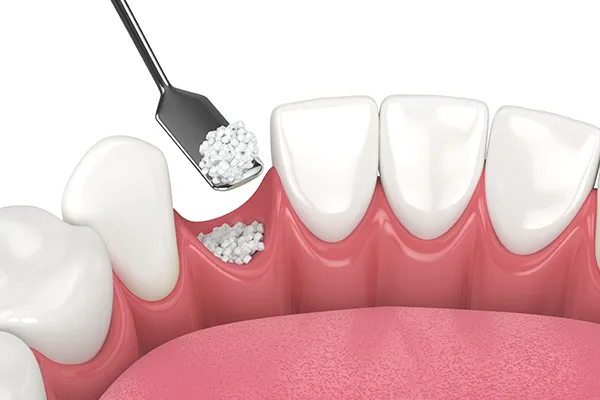Bone Grafting for Dental Implants
 Bone grafting for dental implants is a crucial preparatory procedure for patients with insufficient jawbone density. Whether due to tooth loss, periodontal disease, or trauma, bone loss can compromise the stability of dental implants. By rebuilding the jawbone, bone grafting ensures a solid foundation for successful implant placement and long-term oral health. Bone grafting for dental implants is a crucial preparatory procedure for patients with insufficient jawbone density. Whether due to tooth loss, periodontal disease, or trauma, bone loss can compromise the stability of dental implants. By rebuilding the jawbone, bone grafting ensures a solid foundation for successful implant placement and long-term oral health.
What Is Bone Grafting for Dental Implants?
Dental bone grafting involves transplanting bone tissue to areas of the jaw where bone has deteriorated. This procedure is essential for patients experiencing jawbone loss due to:
- Missing teeth
- Gum disease
- Injury or trauma
By regenerating or strengthening the jawbone, bone grafting provides the necessary support for dental implants, enhancing both function and aesthetics.
When Is Bone Grafting Needed?
Bone grafting is typically required when:
- There is insufficient bone volume to support an implant
- Bone density is compromised, affecting implant stability
Diagnostic tools such as X-rays or CBCT scans help assess bone loss. Common scenarios necessitating bone grafting include:
- Long-term tooth loss leading to bone resorption
- Previous implant failures due to inadequate bone support
Ensuring adequate bone density is vital for the success of dental implants.
Types of Dental Bone Grafts
Several types of bone grafts are used in oral surgery bone graft procedures:
| • |
Autograft - Bone harvested from the patient's own body, often from the chin or hip, offering high compatibility and success rates.
|
| • |
Allograft - Donor bone from another human, processed and sterilized, eliminating the need for a second surgical site.
|
| • |
Xenograft - Bone derived from animals, typically bovine, processed to be safe and effective for human use.
|
| • |
Alloplast - Synthetic bone substitutes made from materials like hydroxyapatite, providing a non-biological alternative. |
Each graft type has its advantages and considerations, with the choice depending on the patient's specific needs and medical history.
The Bone Graft Procedure: Step-by-Step
Understanding the dental bone graft procedure helps patients prepare for the process:
1. Consultation and Imaging: Evaluation using X-rays or CBCT scans to assess bone loss.
2. Anesthesia: Administration of local anesthesia or sedation for comfort.
3. Graft Placement: Surgical insertion of the chosen graft material into the deficient area.
4. Stabilization: Securing the graft with membranes or screws if necessary.
5. Healing: Allowing time for the graft to integrate with the existing bone.
Post-operative care includes avoiding pressure on the graft site and adhering to dietary recommendations to facilitate healing.
Sinus Lift and Other Specialized Grafts
In cases where the upper jaw lacks sufficient bone height, a sinus lift for implants may be performed. This involves:
- Elevating the sinus membrane
- Inserting bone graft material beneath the sinus cavity
Other specialized procedures include ridge expansion for patients with narrow jawbones. These advanced techniques address severe bone loss, enabling successful implant placement.
Healing and Recovery After a Bone Graft
Recovery from a bone graft varies based on the graft type and individual health factors. Typical healing stages include:
- **Initial Healing (First Week)**: Managing swelling and discomfort.
- **Early Bone Formation (2-4 Weeks)**: New bone cells begin to develop.
- **Intermediate Healing (1-3 Months)**: Continued bone growth and strengthening.
- **Final Maturation (3-6 Months)**: Full integration of the graft with existing bone.
Patients are advised to follow post-operative instructions, maintain a soft food diet initially, and attend follow-up appointments to monitor progress.
Benefits of Bone Grafting for Dental Implants
Undergoing bone grafting offers several long-term benefits:
| • |
Enhanced Implant Stability - Provides a solid foundation for dental implants, increasing their longevity.
|
| • |
Preservation of Facial Structure - Prevents the sunken appearance associated with bone loss.
|
| • |
Improved Oral Function - Restores the ability to chew and speak effectively.
|
| • |
Prevention of Further Bone Loss - Stimulates natural bone regeneration, maintaining oral health. |
These advantages contribute to both functional improvements and aesthetic enhancements, supporting overall dental restoration goals.
FAQs
Can implants and bone grafts be done at the same time?
In certain cases, implants and bone grafts can be placed simultaneously. However, this depends on the extent of bone loss and the specific clinical scenario. Your dentist will determine the best approach based on your individual needs.
Is the bone graft procedure painful?
Patients typically experience minimal discomfort during the procedure due to anesthesia. Post-operative pain is usually manageable with prescribed medications and subsides within a few days.
How long before I can get my implant after a bone graft?
The healing period before implant placement varies but generally ranges from 3 to 6 months. This allows the graft to integrate fully with the existing bone, ensuring implant stability.
Are bone grafts always successful?
While bone grafts have a high success rate, outcomes can vary based on factors like overall health, oral hygiene, and adherence to post-operative care. Regular follow-ups with your dental provider are essential to monitor healing and address any concerns.
|

 Bone grafting for
Bone grafting for